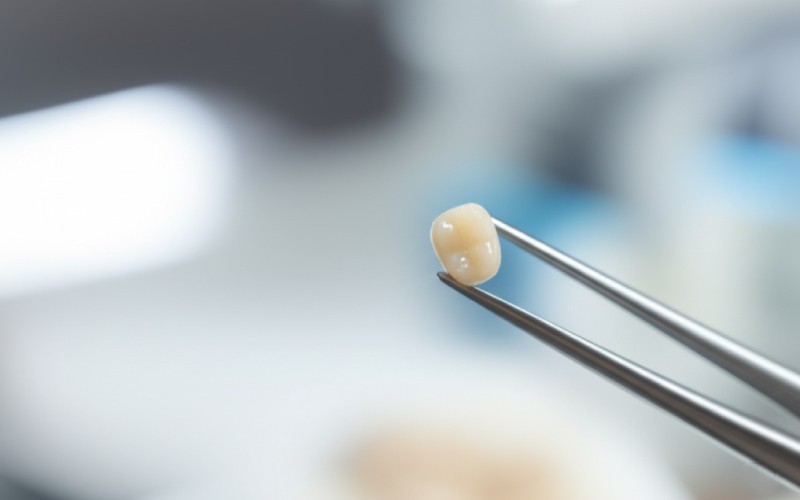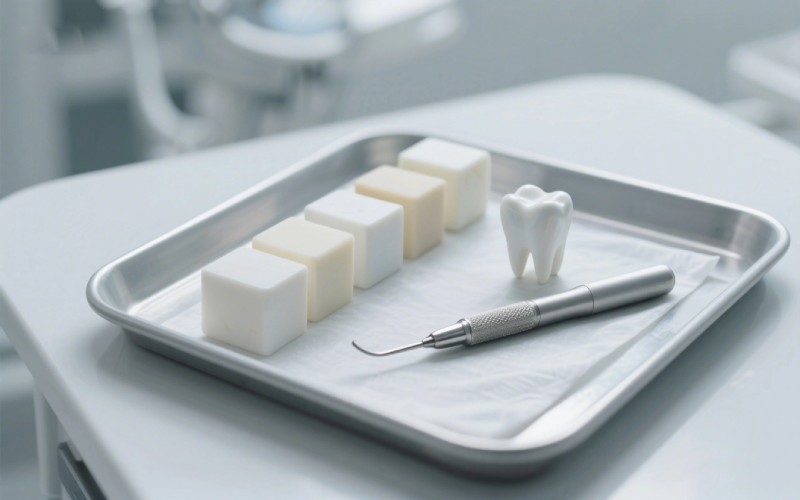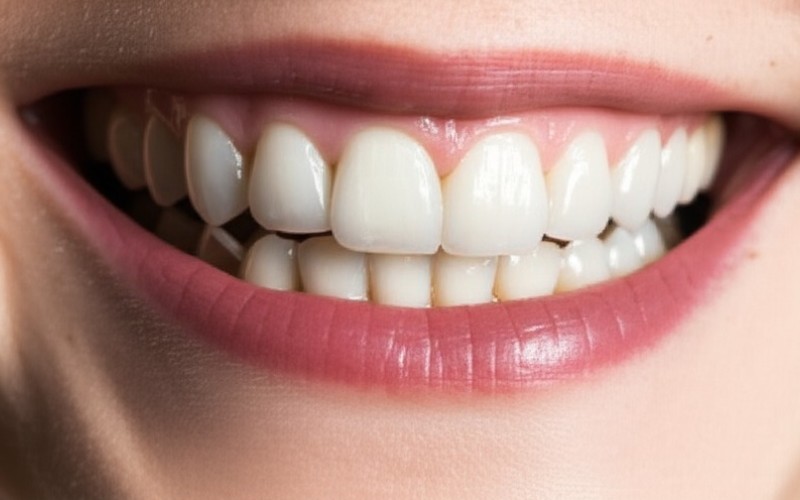
What is the Best Temporary Crown Material for Your Dental Crown?
A temporary crown is a cap that looks like a tooth. Your dentist puts it over a tooth that has been worked on. It is a short-term fix. It helps keep your tooth safe. You have to wait for your permanent crown to be made by a dental lab. You can think of it like a stand-in. It keeps your tooth safe. It also lets you eat and talk like you normally do. This article will help you learn about the different kinds of materials used for temporary crowns. You will also see why picking the right one is a big deal for your mouth’s health.
Table of Contents
What is a temporary crown and why do I need one?
Getting a dental crown usually means you have to visit the dentist two times. On your first visit, your dentist gets your tooth ready for the permanent crown. This means changing the shape of the tooth. This makes space for the new crown. Then, a temporary crown is put over the prepared tooth to keep it safe. This temporary fix is very important. It guards the tooth from getting hurt or feeling sensitive. It also stops your other teeth from moving around. If they moved, your final crown might not fit right.
A temporary crown does several key jobs:
- Protection: It covers the tooth that was worked on. This protects it from germs and stops it from feeling sore.
- Functionality: It lets you chew food and talk normally while you wait for your permanent crown.
- Aesthetics: It fills the empty space, so it does not look like you are missing a tooth.
- Spacing: It holds the right amount of space for the permanent crown. This helps make sure the new crown fits perfectly.
What are the different materials used for temporary dental crowns?
Dentists have a few choices for the material used to make a temporary crown. The most common kinds are acrylic-based resins and composite resins. There are also crowns that are already made. These are called pre-formed crowns. They can be made from materials like polycarbonate or even metal. Every material has good and bad points. The best one for you will depend on what you need.
Here’s a quick look at the common materials:
- Acrylic Resins: These include polymethyl methacrylate (PMMA) and polyethyl methacrylate (PEMA). They are easy for your dentist to use.
- Composite Resins: Bis-acryl composites are a popular choice. They offer good strength and a look that is natural.
- Pre-Formed Crowns: These can be made of polycarbonate (a kind of plastic) or metal, like stainless steel or aluminum.

How does a dentist choose the best temporary crown material for a patient?
I always think about a few important things before picking a material for a temporary crown. First, I think about how long the patient will need to wear the temporary fix. If it’s for a short time, a simple material can work well. But if it’s for a longer time, a stronger material is a better choice. Where the tooth is in the mouth is also important. A front tooth needs a material that looks good and natural.
Patient comfort is another big thing to think about. Some materials can make heat when they get hard, which might not feel good. I also check to see if the patient has an allergy to any material. In the end, I want to pick a material that will keep the patient’s tooth safe. It should also be comfortable until the permanent crown is ready. The plan is to pick a material that fits the specific dental needs of every patient.
Are acrylic resins a good choice for a temporary crown?
Acrylic resins, like polymethyl methacrylate (PMMA) and polyethyl methacrylate (PEMA), are used a lot for temporary crowns. One of the best things about acrylic is that it is easy for me to shape. I can also fix it easily right in the office while you are here. This makes everything fast and simple for you. Acrylics also do not cost a lot of money.
But, there are some not-so-good things about acrylic. When the acrylic material gets hard, it can make heat. This might feel warm on your tooth. This material can also change color over time. It may not be as strong as other materials. So, acrylic is a good choice for many people. But it might not be the best pick if the temporary crown needs to last for a long while.
What about composite resin for a temporary crown?
Composite resins, and especially bis-acryl composites, are another really good choice for temporary crowns. They have some big pluses when you compare them to acrylics. One of the best things is that they look better. Composite resins look more natural, like your own teeth. This makes them a great choice for your front teeth. They also do not get as warm when they harden. This makes them more comfortable for you.
But, composite resin materials can break more easily than acrylics. This means they could crack if you are not careful. Even so, the strength and natural look of composite resin make it a very popular choice. Dentists use it a lot to make a strong and nice-looking temporary fix.
Are there pre-formed temporary crown options?
Yes, pre-formed crowns are another kind of temporary fix. They are like shells that are already made. They come in many sizes and shapes. I can pick a pre-form crown that is a good match for the patient’s tooth. Then I can change it a little to make it fit better. Common materials used to make pre-formed crowns are polycarbonate and aluminum.
Here’s a simple table of pre-formed crown materials:
| Material | How It Looks | Best For |
|---|---|---|
| Polycarbonate | Like a tooth | Front teeth where looks are important. |
| Aluminum/Stainless Steel | Like metal | Back teeth where being strong is more important than how it looks. |
The best thing about pre-formed crowns is that they can be a very fast and easy choice. But, because they are not made just for you from the start, they might not fit as perfectly as a crown made right in your mouth.
Can a temporary crown be made of zirconia?
In the past, dentists used materials like acrylic and composite resin for temporary crowns. Zirconia is a very strong and long-lasting ceramic. It is usually used for permanent crowns. It is known for being very strong and looking natural. Zirconia itself is not usually used to make a temporary crown in the old way. But new digital tools in dentistry are making things different.
With new computer technology, it is now possible to make temporary fixes from blocks of composite material right in the office. Some dental labs can even 3D print temporary solutions. They use special resins for people who need them for a long time. So, you probably will not get a temporary crown made only of zirconia. But these digital ways allow for temporary fixes that are very exact, strong, and good-looking. They can also be made very fast.
How is a temporary crown fabricated?
There are two main ways I can make a temporary crown for a patient. One is called the direct technique. The other is the indirect technique. Which one I choose depends on your dental needs. Both ways are used to make a temporary fix that fits well and keeps the tooth safe.
- Direct Technique: With this way, I make the temporary crown right in the patient’s mouth. I use a material like acrylic or composite resin. I also use a mold of the tooth that I took before working on it. This is a very fast and easy way to make a temporary crown in one visit.
- Indirect Technique: For the indirect way, I take a mold of the prepared tooth. Then I send it to a dental lab. A person at the dental laboratory then makes the temporary crown on a copy of the tooth. This way often fits better, but it takes more time.

What is the advantage of a custom-made temporary crown?
A custom-made temporary crown has big pluses for fit and comfort. It doesn’t matter if it’s made right in the office or at a dental lab. Because it is made just for your tooth, it will fit much better than a pre-formed or “off-the-shelf” crown. A better fit helps keep the tooth underneath safe from germs and soreness.
A custom-made temporary crown also helps form the gums around the tooth in the right way. This can make your final crown look even better. I can also check to make sure your bite feels right when you chew. Pre-formed choices are easy, but a custom-made temporary crown gives a higher level of care. It is a better temporary fix while you wait for your permanent restoration.
How long should a temporary crown last?
A temporary crown is made to be used for a short time. This is usually for a few weeks. You wear it while your permanent crown is being made at a dental laboratory. Most people wear their temporary crown for about two to three weeks. How long you wear it can change. It depends on your dental plan and how long the dental lab takes to make your permanent fix.
It is good to remember that temporary crowns are not as strong as permanent crowns. They are usually made from materials that are not as tough. They are put on with a temporary glue so they are easy to take off. That is why it is so important to be careful with your temporary crown. You should follow the care instructions your dentist gives you.
To Sum It Up
- A temporary crown keeps your tooth safe after it is ready for a permanent crown.
- The most common materials for temporary crowns are acrylic and composite resins.
- Your dentist picks the best material for you. The choice is based on how long you need it, where the tooth is, and your comfort.
- Acrylic costs less and is simple to use. Composite resin looks better.
- Pre-formed crowns are a fast choice, but they might not fit as well as custom-made ones.
- You will probably wear a temporary crown for two to three weeks.
- Taking good care of your temporary crown is important to keep it from breaking.




